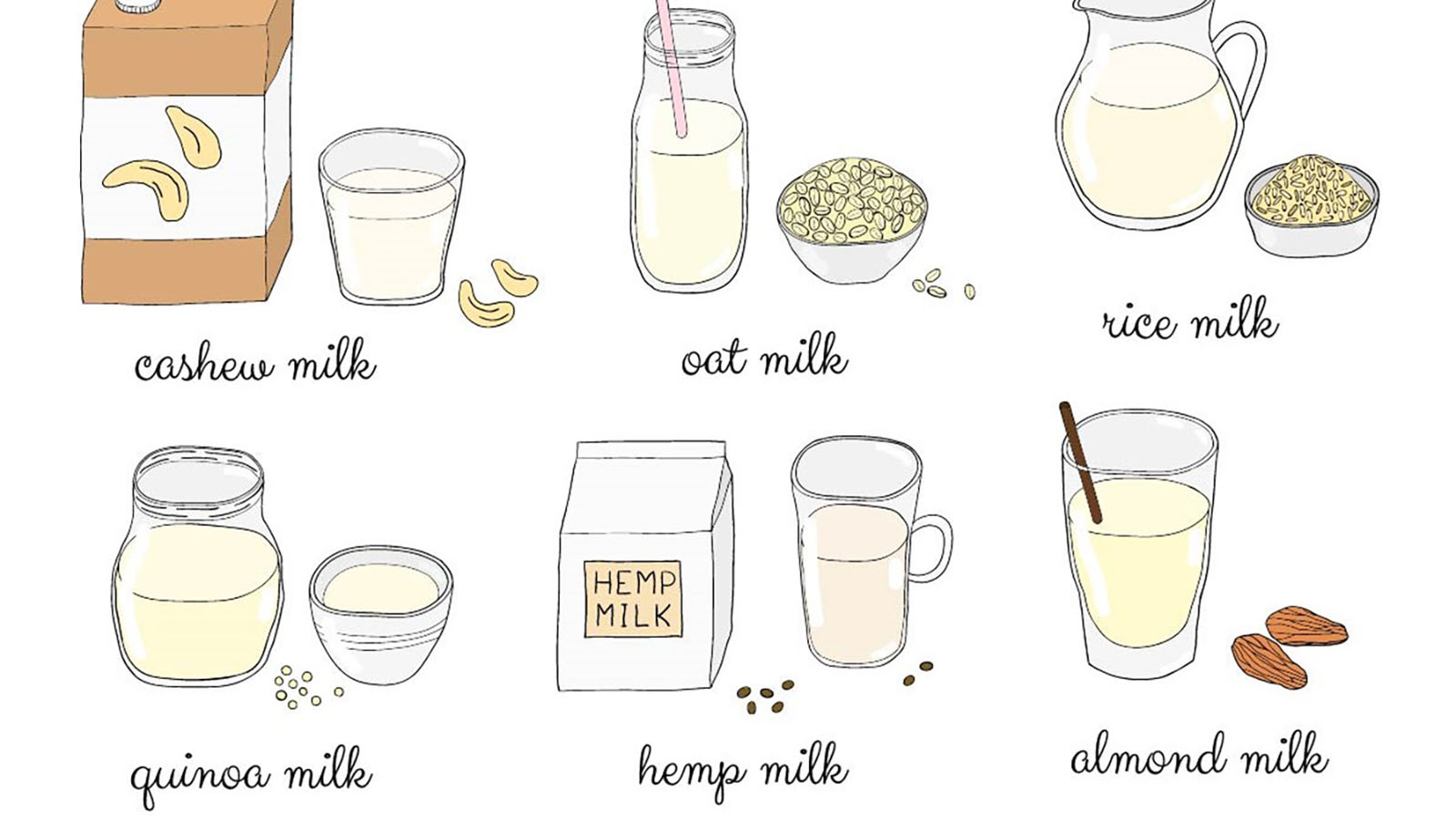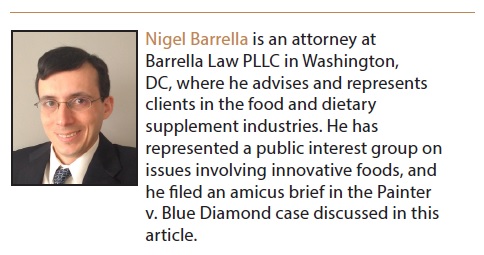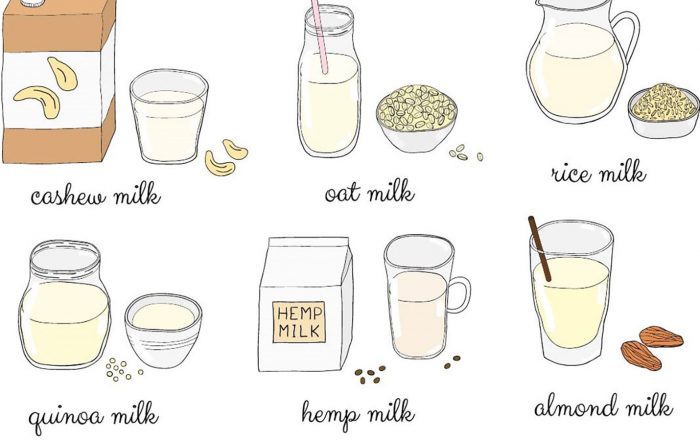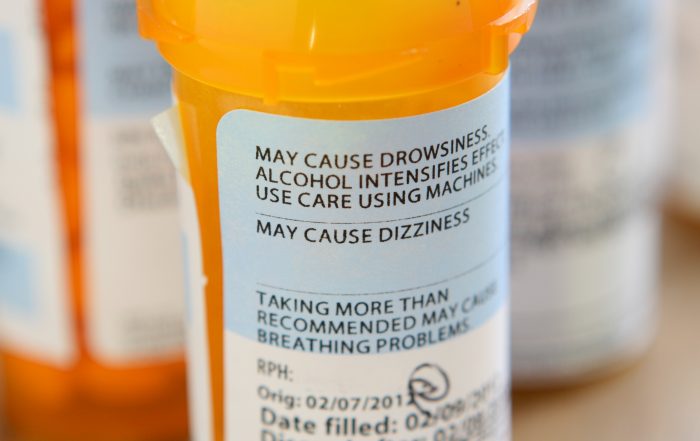
Soy Milk, Spilt Milk? FDA’s Next Free Speech Conundrum: As FDA Considers the Labeling of Dairy Alternatives, First Amendment Questions Loom Large
by Nigel Barrella
 Has the First Amendment recently been increasingly “weaponized” against economic- and health-related laws and regulations? This was the concern expressed by Justice Elena Kagan in a dissenting opinion last year in a major case about public-sector unions. “Speech is everywhere,” she wrote, “part of every human activity,” and so “almost all economic and regulatory policy affects or touches speech.”1 Consequently, she argued, almost all economic and regulatory policy may be subjected to review under the First Amendment, forcing courts to make public policy decisions that were traditionally left to the democratic branches. While debates over the proper role of courts are nothing new, the recent shift by the courts to a more active (some might say “activist”) role on commercial speech is undeniable.2
Has the First Amendment recently been increasingly “weaponized” against economic- and health-related laws and regulations? This was the concern expressed by Justice Elena Kagan in a dissenting opinion last year in a major case about public-sector unions. “Speech is everywhere,” she wrote, “part of every human activity,” and so “almost all economic and regulatory policy affects or touches speech.”1 Consequently, she argued, almost all economic and regulatory policy may be subjected to review under the First Amendment, forcing courts to make public policy decisions that were traditionally left to the democratic branches. While debates over the proper role of courts are nothing new, the recent shift by the courts to a more active (some might say “activist”) role on commercial speech is undeniable.2
This ongoing doctrinal evolution has had a marked impact on food and drug law. To briefly review a few examples: After Pearson v. Shalala,3 FDA was forced to develop procedures for allowing qualified health claims on food and dietary supplements. In Thompson v. Western States Medical Center,4 the ban on advertising compound drugs was struck down. In Sorrell v. IMS Health,5 a state restriction on the sale of prescription data to marketers was held unconstitutional as a speaker-based restriction triggering some undefined form of “heightened” constitutional scrutiny. More recently, a court invalidated FDA’s regulation for graphic warning labels on cigarettes,6 and the Caronia7 and Amarin8 decisions (following Sorrell) have limited FDA’s ability to police off-label marketing of pharmaceuticals.
If these are just some examples from the past 20 years, one may wonder where this commercial-free-speech tide will take us over the next 20. With the recent spate of judicial appointments, Justice Kagan’s more restrained and minimalist view of the First Amendment might be destined to be a minority view on the federal bench for a generation. One can imagine future decisions invalidating the limited procedures FDA has created for vetting qualified health claims and off-label marketing statements; or restrictions on direct-to-consumer advertising, including for off-label uses of approved drugs; or conditions on the use of “potentially misleading” nutrient-content claims on food. Nor is it hard to imagine—at least for foods and supplements that raise no concerns of toxicity or side effects—FDA’s role being limited to postmarket enforcement against outright false and inherently misleading statements, narrowly defined. In other words, food labels may someday freely tout the latest findings in nutrition science, complete with express or implied claims about disease prevention or treatment. (Cheerios for heart disease, anyone?) Similarly, marketing for dietary supplements could someday be unleashed to make more aggressive and “drug-like” claims.
While some may welcome this imagined “free market” of the future, most readers of this magazine probably believe that FDA’s authority in these matters plays an important role in protecting public health. Few would welcome a return to the days of the snake-oil salesmen, or the replacement of the Food, Drug and Cosmetic Act’s (FDCA) consumer protection provisions with the law of caveat emptor. FDA is bound to do all it can to resist the narrowing of its authority. But from the examples cited above, it is increasingly clear that the agency is playing defense on many fronts.
Some commentators have attributed FDA’s losses in court to the agency’s own regulatory overreach. Whatever the merits of such characterizations, the agency may be smart to avoid (as much as possible) actions or policies that could be so characterized. Just as some private parties hope to find the ideal “test case” to establish a principle of law, FDA would do well to be strategic in picking those battles that best highlight its unique and science-oriented role in protecting consumers’ health.
But there is one possible commercial-speech controversy looming on the horizon, one that involves a question more of common sense than of public health; more of semantics than of science. The question, which FDA is now seriously considering: what, exactly, is “milk?”
* * *
“An almond doesn’t lactate, I will confess.” So stated Commissioner Gottlieb (in reference to almond milk) in an interview in July 2018. This remark immediately attracted an unusual degree of attention, providing fodder for political pundits, social media debates, and late-night comedians. Speaking the following week at the public meeting on FDA’s Nutrition Innovation Strategy, Commissioner Gottlieb joked about his regret in stepping into this issue, remarking that he was “done” commenting on what almonds are “capable of doing.” At the same time, he released a longer written statement describing why FDA was looking at the issue of dairy-alternative nomenclature and what factors the agency was considering.
While this was FDA’s first public foray into the topic, regulatory questions about dairy alternatives (like soy and almond milk) had been simmering for years. In the late 90s, the National Milk Producers Federation (NMPF) began campaigning for FDA to reject the name “soymilk” as the common or usual name for that familiar food. Over time, facing the increased availability of soymilk and other dairy alternatives on grocery shelves, NMPF began to submit more public comments urging FDA to act on what they called an “infringement” on the standard of identity for “milk.” Eventually members of Congress (often from major dairy-producing states) began echoing these comments, and in 2017, a group of them proposed legislation named the “DAIRY PRIDE Act,”9 which would amend the FDCA to prohibit non-dairy food labels from referencing dairy language.
Commissioner Gottlieb’s statements in July 2018 acknowledged the plant milk question as framed by dairy producers: whether FDA was failing to enforce the standard of identity for “milk.” At the same time, he noted one counterpoint that had been raised: dictionary definitions of “milk” often include white liquids from plants and nuts, like coconut or almond milk. (This sort of linguistic flexibility is very common generally; consider peanut butter, cream of wheat, and root beer, distinct from butter, cream, and beer.) Notably, here the Commissioner made an explicit connection to First Amendment concerns, suggesting that the realities of ordinary language might limit the agency’s possible actions.
Coming from this angle of common language, FDA is not writing on a blank slate. Courts repeatedly decided cases involving plant milks over the past decade. Several consumer class-action lawsuits leveled the dairy industry’s misbranding theories against soy and almond milk, resulting in dismissals as judges found no issues of consumer confusion or deception. Addressing the purported “violation” of milk’s standard of identity, one court noted that under this theory of misbranding, a “consumer might also believe that veggie bacon contains pork, that flourless chocolate cake contains flour, or that e-books are made out of paper.”10
In one case heard by the 9th Circuit in December, plaintiffs had alleged that “almond milk” should be labeled “imitation milk” due to lower levels of certain nutrients. At oral argument, the judges gave little credence to this technical argument, noting simply that the very name “almond milk” implied a product distinct in kind, rather than a product imitating cow’s milk. By memorandum speedily issued 17 days after argument, the panel affirmed the district court’s dismissal, rejecting arguments that the name “almond milk” constituted misbranding or deceived consumers in any way.11 From cases such as these, it seems that judges—like the rest of us—are familiar with these products under common names, and are prepared to apply that common sense to the disputes before them.
If FDA were to try to ban “milk” and other dairy terms from non-dairy product labels, what justification could it offer to overcome the ordinary-language and common-sense arguments that have persuaded judges in the past? Or, in First Amendment commercial-speech terms, what is the substantial state interest? The Commissioner’s written remarks noted the existence of case reports of malnutrition when infants were exclusively fed certain plant milks. Similarly, in FDA’s recent Request for Information on dairy alternatives,12 FDA noted it was seeking data and evidence about consumer understanding of nutritional differences. It appears FDA’s most likely justification for any such action involves nutritional implications of consuming certain plant-based alternatives.
One problem with this approach, however, is the loose connection between any proposed restriction on dairy terms and the nutritional qualities of plant-based products. Under commercial speech analysis, a proposed restriction must have a reasonable relationship to the asserted state interest and be no more extensive than necessary. One problem is that plant-based dairy alternatives vary so widely in nutritional properties, starting from different plant bases and adding varying degrees of vitamin fortification. (One may note here that dairy products also have varying nutrition and fortification, as with vitamin D.) And many non-dairy products have nutrients that dairy lacks (such as iron or vitamin E) or have fewer calories and superior fatty acid profiles (unsaturated vs. saturated). Can it categorically be said that regulating semantics is a reasonable means for improving consumers’ nutritional “milk” choices?
Meanwhile, less categorical policies would raise different issues. The European approach is one example: the EU generally forbids the use of dairy terms on non-dairy products, but it also maintains a long list of exceptions in its member languages for foods of historical or cultural significance—including, in many languages, almond milk and coconut milk.13 So while lait d’amande and Kokosmilch are essentially grandfathered by their historical pedigree, a more nutritionally-complete recent arrival from China (soy milk) is verboten from using the m-word in all EU member states.
Insofar as this scheme picks winners and losers for (at best) historical reasons, these European-style restrictions seem out of place in our political and economic system. The language-regulating approach also carries an undercurrent of paternalism—the language used in a product’s name so powerful that it over-comes consumers’ ability to compare and decide on the nutritional benefits and drawbacks of different products?
And to return to the theme discussed at the outset of this article, this approach would also run against the tide of commercial speech jurisprudence. Both the categorical and the case-by-case approaches to regulating language would be, in the words of Sorrell, content- and speaker-based restrictions on speech triggering “heightened” scrutiny. The proposal would be content-based because it would target plant milks specifically (and perhaps not all equally). And a proposed ban on dairy language would be speaker-based just as in Sorrell and Caronia: it would only apply to producers and sellers of the plant-based products.
But taking a step back from the doctrinal arguments, the optics of this issue are equally worth considering. Would this really be the ideal “test case” on which FDA should hang its credibility and authority to supervise matters of labeling? As noted above, FDA is now considering action following a decades-long campaign by a well-established market player, complete with pressure from Congress and proposed legislation with an explicitly protectionist title and stated purpose. And it would do so on a matter where several courts, applying common knowledge and common sense, have already concluded that there is no risk of even unsophisticated consumers being confused, deceived, or harmed. It would be difficult to envision a constellation of facts that better supports a common refrain of the libertarian worldview: that a powerful government cannot be trusted to act solely in the public’s interest, because (whether by intention or not) its awesome powers will inevitably be used or abused in favor of connected, established, entrenched interests.
To return to the words of Justice Kagan, one could easily argue that the “First Amendment was meant for better things” than deciding the meaning of “milk.” But so, too, was FDA’s statutory authority “meant for better things” than favoring one industry at the expense of another. One may simultaneously question the wisdom of the latest incarnation of commercial speech doctrine, while understanding the situational wisdom of the different view of liberty driving the doctrine’s current evolution. If FDA asserts itself on this issue of all things, I believe it will likely lose—and quite possibly to the long-term detriment of the “better things” in the agency’s mission.
Update Magazine
February/March 2019
- Janus v. State, County, and Municipal Employees, Council 31, 138 S.Ct. 2448, 2501–02 (2018) (Kagan, J., dissenting).
- For a detailed and FDA-specific discussion of this issue, see Amy Kapczynski, The Lochnerized First Amendment and the FDA: Toward a More Democratic Political Economy 118 Colum. L. Rev. Online 179 (2018).
- 164 F.3d 650 (D.C. 1999).
- 535 U.S. 357 (2002).
- 564 U.S. 552 (2011).
- R.J. Reynolds Tobacco Co. v. FDA, 696 F. 3d 1205 (D.C. 2012).
- U.S. v. Caronia, 703 F.3d 149 (2d Cir. 2012).
- Amarin Pharma v. FDA, 119 F. Supp. 3d 196 (S.D.N.Y. 2015).
- In classic congressional form, this is an acronym of “Defending Against Imitations and Replacements of Yogurt, milk, and cheese to Promote Regular Intake of Dairy Everyday.”
- Ang v. WhiteWave Foods Co., 2013 WL 6492353 (N.D. Cal., Dec. 10, 2013).
- Painter v. Blue Diamond Growers, No. 17-55901, 2018 WL 6720560 (9th Cir. Dec. 20, 2018).
- 83 Fed. Reg. 49103 (Sept. 28, 2018).
- See EC No. 1234/2007; 2010/791/EU.







